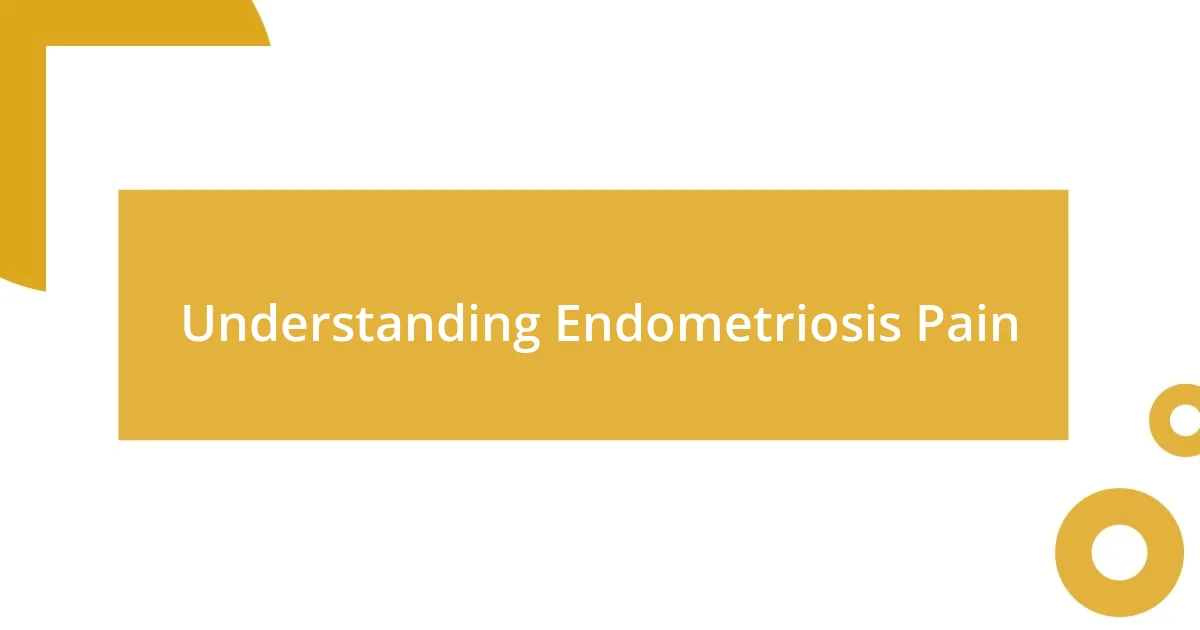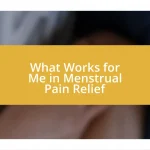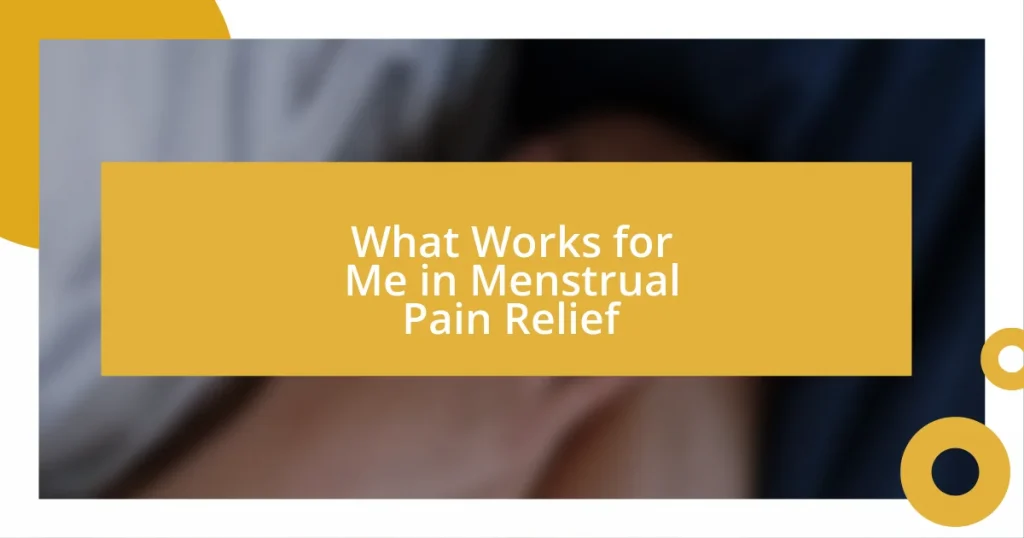Key takeaways:
- Endometriosis pain is unpredictable and affects both physical and emotional well-being, requiring attention to symptoms like pelvic pain, fatigue, and emotional isolation.
- Management of endometriosis pain hinges on a combination of medications, lifestyle changes, and alternative therapies such as exercise, dietary adjustments, acupuncture, and yoga.
- Support resources, including support groups and mental health therapy, are essential in navigating the emotional challenges of living with endometriosis, providing connection and knowledge.

Understanding Endometriosis Pain
Endometriosis pain can often feel like an unseen burden, lurking beneath the surface and transforming everyday life into a constant struggle. I remember sitting in a meeting, trying to focus, while a sharp stabbing pain shot through my abdomen, making it nearly impossible to concentrate. Have you ever felt that way, where the world keeps moving, but you feel like you’re stuck in a painful pause?
What’s particularly perplexing is how each menstrual cycle can bring a completely different experience of pain. One month, it might be a dull ache, while the next could leave me doubled over in excruciating pain. It’s almost like my body enjoys throwing unexpected curveballs! This unpredictability can make it challenging to plan anything, as I constantly wrestle with the fear of being caught off guard.
I’ve discovered that it’s not just the physical pain; there’s an emotional weight that accompanies it as well. It’s that feeling of isolation when you can’t muster the energy to participate in social gatherings—have you experienced that? Over time, I realized that the emotional toll of endometriosis pain can sometimes overshadow the physical symptoms, creating a cycle that’s hard to break.

Symptoms of Endometriosis Pain
The symptoms of endometriosis pain can vary widely, making it difficult to pin down exactly what to expect. I vividly remember a time when I was attending a family gathering, and suddenly, I was hit with a wave of fatigue that drained every ounce of energy from my body. It’s as if a heavy blanket descended, making simple conversations feel like climbing a mountain. This fatigue is often accompanied by more recognizable symptoms, like intense cramping and heavy periods, but they only scratch the surface of what endometriosis can entail.
Here’s a quick overview of some common symptoms associated with endometriosis pain:
- Pelvic pain: Often severe, can occur during menstruation or ovulation.
- Dysmenorrhea: Painful periods that can start before and extend after the bleeding.
- Fatigue: An overwhelming sense of tiredness that doesn’t fade with rest.
- Painful intercourse: Discomfort during or after sexual activity.
- Bloating and digestive issues: Including nausea, diarrhea, or constipation.
- Lower back pain: Often exacerbated during menstrual periods.
- Infertility: Difficulty in conceiving, commonly leading to further emotional distress.
Each symptom can alter daily life in unexpected ways, making it crucial to recognize and validate the experience. I learned that acknowledging these feelings and symptoms helped me take small steps towards better management and understanding of my own body. It’s such a journey, realizing that I’m not alone in this; many share similar struggles, and in that, we find a sense of solidarity.

Methods of Managing Pain
Managing the pain associated with endometriosis requires a multi-faceted approach. I found that pain relief pathways can range from medication to holistic practices. When I first began exploring pain management options, I was overwhelmed by the variety available. Over the years, I’ve tried various methods, each offering unique benefits.
In my experience, medication options, from NSAIDs to hormonal treatments, can provide relief but often come with side effects. I recall a time when I relied heavily on these, only to discover that lifestyle changes had remarkable effects. Regular exercise and dietary adjustments helped reduce my symptoms significantly. It’s fascinating how the mind and body are interconnected—sometimes just a brisk walk or a nourishing meal can shift the pain levels dramatically.
Additionally, some may find relief in alternative therapies like acupuncture or yoga. These methods have a calming effect that can reduce not just physical symptoms but also anxiety surrounding the pain. I remember attending my first yoga class with skepticism but left feeling an unexpected sense of peace. That was a turning point for me, realizing that managing endometriosis is often about finding balance and understanding what works best for my specific needs.
| Method | Description |
|---|---|
| Medications | Includes NSAIDs and hormonal treatments, often providing immediate relief but may have side effects. |
| Exercise | Regular physical activity can help manage pain and improve overall well-being. |
| Dietary Changes | Incorporating anti-inflammatory foods may lead to significant symptom relief. |
| Alternative Therapies | Includes acupuncture and yoga, promoting relaxation and pain reduction through holistic approaches. |

Medication Options for Endometriosis
When it comes to medication options for endometriosis, I’ve tried several routes, each influencing my pain management journey in different ways. Nonsteroidal anti-inflammatory drugs (NSAIDs), like ibuprofen, quickly became my go-to for immediate relief. I remember the days when a simple tablet would help me regain control during my most intense cramping episodes, allowing me to attend family functions without wincing in pain. However, I quickly learned that while they provide temporary respite, they sometimes come with unwanted side effects, like stomach discomfort. Have you ever weighed the pros and cons of quick fixes versus long-term solutions?
As I continued my search for effective treatment, hormonal medications presented themselves as another option. I recall sitting down with my doctor, feeling hopeful yet anxious about the prospect of birth control pills or hormone therapy. Initially, they sounded promising—many women I spoke to claimed they experienced fewer symptoms. However, my experience wasn’t quite as straightforward; it took time to find the right dosage that balanced effectiveness with how I felt emotionally and physically. It’s a dance of trial and error, isn’t it?
I also explored other medications like GnRH agonists which essentially put the body in a temporary menopause state. I’ll never forget how daunting that sounded, but I was willing to try anything to ease the agony I felt each month. While they did help with pain reduction, the emotional swings and side effects were another layer of complexity. It’s essential to consult with your healthcare provider about what’s best for you. Each woman’s experience is unique, and finding the right medication can feel like navigating a maze on your own. How do you feel about the myriad of options? The key is to keep an open line of communication with yourself and your doctors—this journey is personal, and so is the path to relief.

Lifestyle Changes for Pain Relief
Lifestyle changes can make a world of difference when managing endometriosis pain. I remember the moment I decided to revamp my diet, swapping out processed foods for a variety of fruits, vegetables, and lean proteins. Not only did I enjoy the meals more, but I genuinely felt a decrease in my symptoms. It’s interesting how what we fuel our bodies with can transform our physical experience—was it the nutrients, or just a more mindful way of eating?
Incorporating regular exercise into my routine became another pivotal change. Initially, I dreaded it; the thought of moving my body seemed daunting on days filled with pain. But as I pushed through that barrier, I discovered that gentle activities like walking and stretching actually helped ease my discomfort. I can’t stress enough the importance of listening to your body—some days it called for light movement, while other days required complete rest. Have you found that sweet spot between exertion and relaxation?
Lastly, I found that prioritizing sleep was often overlooked in my pain management plan. I invested in creating a cozy sleep environment and established a calming bedtime routine. Those nights when I managed to sleep well, I noticed a significant reduction in my pain levels the following day. It’s incredible how interconnected our routines are—how many of us overlook the power of a good night’s rest in managing chronic pain? All these changes require patience and persistence, but the journey becomes worthwhile when you notice your health improving day by day.

Alternative Treatments and Therapies
Alternative therapies can provide a refreshing approach to managing endometriosis pain. I remember the first time I tried acupuncture—it was almost like stepping into a different realm of healing. As those tiny needles went in, I felt a wave of calm wash over me, and it was fascinating to see how it tapped into my body’s energy. For many, including myself, acupuncture not only alleviated pain but also fostered a sense of well-being that I didn’t expect. Have you ever explored something unconventional and found solace in it?
Another option I delved into was yoga, which, in hindsight, feels like a gift I didn’t know I needed. The first time I joined a class, I nearly walked out due to my insecurities and discomfort. But once I immersed myself in the practice, I discovered an amazing blend of stretching and mindfulness that eased my tension. The deep breathing and gentle movements significantly aided in managing my pain, transforming my approach to self-care. Isn’t it incredible how something as simple as being in tune with your body can lead to relief?
Lastly, I dabbled with herbal remedies with mixed results. After doing extensive research, I decided to try certain supplements like turmeric and ginger. I remember the initial nervousness I felt about taking something outside standard medication, wondering if it would help or hinder my journey. Surprisingly, I found that these natural options gave my body a little extra support, particularly when my symptoms flared up. Have you considered harnessing nature’s arsenal in your treatment plan? It’s worth discussing with a knowledgeable healthcare provider if you’re curious about how herbal therapies might fit into your unique experience.

Support Resources for Patients
Support resources are crucial for anyone navigating the challenges of endometriosis. During my journey, I discovered support groups, both online and in-person, that provided a safe space to share experiences and emotions. Connecting with others who truly understood my struggles made me feel less isolated—have you ever felt the power of shared empathy in your own life?
Another invaluable resource I found was educational workshops and seminars hosted by healthcare professionals. Attending one of these sessions was a turning point for me; I learned more about my condition and various management strategies directly from experts. It was empowering to ask questions and gain knowledge that felt applicable. Have you taken the time to investigate local events that might help you learn and grow in your understanding of endometriosis?
Finally, don’t underestimate the importance of mental health support. Therapy became a sanctuary for me, offering a space to process my feelings about living with chronic pain. I often left sessions feeling lighter, armed with coping tools that were tailored to my unique situation. Isn’t it comforting to know that prioritizing mental well-being can significantly enhance our overall approach to managing physical health? Embracing these resources allowed me to build a supportive network that truly uplifted my journey.














